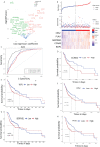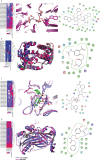Identification of therapeutically potential targets and their ligands for the treatment of OSCC
- PMID: 36203433
- PMCID: PMC9530560
- DOI: 10.3389/fonc.2022.910494
Identification of therapeutically potential targets and their ligands for the treatment of OSCC
Abstract
Recent advancements in cancer biology have revealed molecular changes associated with carcinogenesis and chemotherapeutic exposure. The available information is being gainfully utilized to develop therapies targeting specific molecules involved in cancer cell growth, survival, and chemoresistance. Targeted therapies have dramatically increased overall survival (OS) in many cancers. Therefore, developing such targeted therapies against oral squamous cell carcinoma (OSCC) is anticipated to have significant clinical implications. In the current work, we have identified drug-specific sensitivity-related prognostic biomarkers (BOP1, CCNA2, CKS2, PLAU, and SERPINE1) using gene expression, Cox proportional hazards regression, and machine learning in OSCC. Dysregulation of these markers is significantly associated with OS in many cancers. Their elevated expression is related to cellular proliferation and aggressive malignancy in various cancers. Mechanistically, inhibition of these biomarkers should significantly reduce cellular proliferation and metastasis in OSCC and should result in better OS. It is pertinent to note that no effective small-molecule candidate has been identified against these biomarkers to date. Therefore, a comprehensive in silico drug design strategy assimilating homology modeling, extensive molecular dynamics (MD) simulation, and ensemble molecular docking has been applied to identify potential compounds against identified targets, and potential molecules have been identified. We hope that this study will help in deciphering potential genes having roles in chemoresistance and a significant impact on OS. It will also result in the identification of new targeted therapeutics against OSCC.
Keywords: OSCC; chemoresistance; chemotherapy; drug discovery; prognosis.
Copyright © 2022 Kumari, Kumar, Sethy, Bhue, Mohanta and Dixit.
Conflict of interest statement
The authors declare that the research was conducted in the absence of any commercial or financial relationships that could be construed as a potential conflict of interest.
Figures









Similar articles
-
A Novel Immune-Related Gene Signature to Identify the Tumor Microenvironment and Prognose Disease Among Patients With Oral Squamous Cell Carcinoma Patients Using ssGSEA: A Bioinformatics and Biological Validation Study.Front Immunol. 2022 Jul 6;13:922195. doi: 10.3389/fimmu.2022.922195. eCollection 2022. Front Immunol. 2022. PMID: 35935989 Free PMC article.
-
Identifying Drug Targets of Oral Squamous Cell Carcinoma through a Systems Biology Method and Genome-Wide Microarray Data for Drug Discovery by Deep Learning and Drug Design Specifications.Int J Mol Sci. 2022 Sep 8;23(18):10409. doi: 10.3390/ijms231810409. Int J Mol Sci. 2022. PMID: 36142321 Free PMC article.
-
Up-regulation of survivin in oral squamous cell carcinoma correlates with poor prognosis and chemoresistance.Oral Surg Oral Med Oral Pathol Oral Radiol Endod. 2010 Oct;110(4):484-91. doi: 10.1016/j.tripleo.2010.04.009. Oral Surg Oral Med Oral Pathol Oral Radiol Endod. 2010. PMID: 20868995
-
Translational genomics and recent advances in oral squamous cell carcinoma.Semin Cancer Biol. 2020 Apr;61:71-83. doi: 10.1016/j.semcancer.2019.09.011. Epub 2019 Sep 19. Semin Cancer Biol. 2020. PMID: 31542510 Review.
-
Personalized Targeted Therapeutic Strategies against Oral Squamous Cell Carcinoma. An Evidence-Based Review of Literature.Int J Nanomedicine. 2022 Sep 15;17:4293-4306. doi: 10.2147/IJN.S377816. eCollection 2022. Int J Nanomedicine. 2022. PMID: 36134201 Free PMC article. Review.
Cited by
-
An Integrated Approach of Network Pharmacology, Bioinformatics, Molecular Docking, and Experimental Verification Uncovers Prunellae Spica as the Potential Medicine of Prognosis Improvement for Oral Squamous Cell Carcinoma.Curr Pharm Des. 2025;31(5):391-412. doi: 10.2174/0113816128328547240827045955. Curr Pharm Des. 2025. PMID: 39289945
-
CKIP-1 silencing suppresses OSCC via mitochondrial homeostasis-associated TFAM/cGAS-STING signalling axis.J Cell Mol Med. 2024 Aug;28(16):e70006. doi: 10.1111/jcmm.70006. J Cell Mol Med. 2024. PMID: 39169452 Free PMC article.
-
Expression of 9-O-Acetylated Sialic Acid in HPV+ Oral Squamous Cell Carcinoma Cells.Life (Basel). 2025 Apr 17;15(4):663. doi: 10.3390/life15040663. Life (Basel). 2025. PMID: 40283217 Free PMC article.
-
Chemotherapeutic Drug Resistance Associated with Differential miRNA Expression of miR-375 and miR-27 among Oral Cancer Cell Lines.Int J Mol Sci. 2023 Jan 8;24(2):1244. doi: 10.3390/ijms24021244. Int J Mol Sci. 2023. PMID: 36674758 Free PMC article.
-
Overexpression of a disintegrin and metalloproteinase 9 (ADAM9) in relation to poor prognosis of patients with oral squamous cell carcinoma.Discov Oncol. 2024 Oct 23;15(1):582. doi: 10.1007/s12672-024-01422-1. Discov Oncol. 2024. PMID: 39441449 Free PMC article.
References
LinkOut - more resources
Full Text Sources
Miscellaneous

